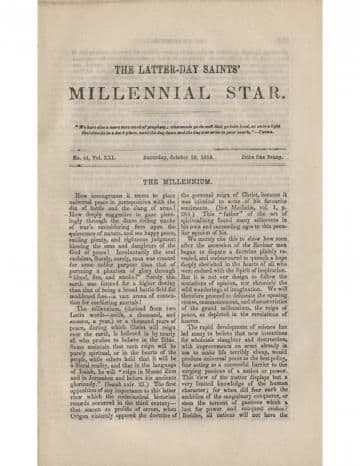Magazine
American Antiquities: Corroborative of the Book of Mormon (29 October 1859)

Title
American Antiquities: Corroborative of the Book of Mormon (29 October 1859)
Magazine
The Latter Day Saints' Millennial Star
Publication Type
Magazine Article
Year of Publication
1859
Editors
Calkin, Asa (Secondary)
Number of Pages
706
Date Published
29 October 1859
Volume
21
Issue Number
44
Abstract
This 47-part series provides evidence to confirm the authenticity of the Book of Mormon. It describes the contents of the Book of Mormon and archaeological findings and discoveries, such as ancient cities, temples, altars, tools, and wells. Each part contains several excerpts from other publications that support the Book of Mormon.
AMERICAN ANTIQUITIES,
CORROBORATIVE OF THE BOOK OF MORMON.
(Continued from page 531.)
Thirty years afterwards, however, the king of Spain sent out an exploring commission under the direction of Captain Del Rio, and subsequently another under Captain On Faix; but, by adverse circumstances, the reports of both these gentlemen were withheld from publication for many years; and it is thus only within the last twenty-five years that any authentic accounts of these Miteresting remains of a bygone civilization have become known to the world in general. Since the publication of the report of the two above-named gentlemen, the ruins have been visited end carefully explored by several enterprising travellers. The last among these, as far as we are aware, was Mr. Stephens, the well-known American writer and traveller, who published in 1839 and in 1342 the result of his researches, illustrated with numerous engravings. In the course of his journey through the several provinces of Honduras, Guatemala, Chiapas, Tabasco, and the peninsula of Yucatan, Mr. Stephens met with no less that forty-four ruined cities, the greater number situated within short distances of each other in Yucatan, but buried in the depths of forests, without any visible moans of communication, and in many cases unknown to the populations within a few hundred yards of whose doors they are. … On the first survey of these wonderful cities of palaces, buried in the bosom of the vast forests of an uncultivated region, the imagination, struck by the presence of so much grandeur and magnificence, and the total absence of all the petty details connected with the daily necessities and the daily cares of human life, conjures up to itself a race of beings exempt from these necessities and these cares, which has dwelt here in happiness and splendour. But sober reason soon re-asserts its sway, and bids us believe that where we find the traces of human habitations, there also, though hidden, we shall find the presence of those conditions without which human nature cannot exist. Thus, though the sites of these cities, particularly in Yucatan, seem selected with an entire disregard of that which is generally considered the first of conditions for the foundation of a city—namely, a natural supply of water, we find, upon nearer investigation, that this seeming indifference with regard to the absence of one of the first necessaries of life must have been owing to the consciousness possessed by these builders of their capability of supplying by art the deficiencies of nature. The wonderful perseverance and industry of this race seems to have recoiled before no difficulties. The same hands that raised the immense artificial mounds to bear aloft their stately palaces and their temples were ready to provide artificial means to supply large populations with water. The ponds and wells which have been found buried in the depths of the forests surrounding the ruined cities, and which were, until very lately, believed by the inhabitants to be natural depressions of the soil, and in most cases looked more like bogs or marshes than like artificial tanks or cisterns, have now been ascertained beyond d doubt to be lined with masonry; and they form a very interesting portion of the ancient works of the aborigines. Several of these ponds, (or aguadas, as they are called by the natives of Spanish descent,) situated on the property of a gentleman more observant than the generality of his countrymen, were entirely dried np by the heats of summer in 1835. The proprietor, placing confidence in the current traditions that they were artificial contrivances and the work of the Antiguos, or ancients, as the Indians denominate the authors of the many ancient works with which their country abounds, availed himself of the opportunity to make a careful examination of the ponds, and was satisfied that on tills point tradition was correct. In 1836 the pond was cleared of mud, and an artificial bottom disclosed, consisting of large flat stones, placed in several layers, the interstices being carefully filled with a reddish-brown clay. In the middle of the basin, sunk from the level of this paved foundation, were four wells, eight yards deep, and five feet in diameter, and lined with stone, but at the time of which we speak filled with mud. Besides these, there were around the margin of the pond upwards of 100 pits, into which the water had filtered, and which, together with the wells, were intended to furnish a supply of water during the dry season of the year, when the upper basin, which depended upon the floods of the rainy season, should be empty. On another estate within a short distance of the one we have just mentioned, another aguada of a still more extraordinary character has been cleansed and restored to its original uses.
(To be continued.)
Subject Keywords
Bibliographic Citation
Terms of use
Items in the BMC Archive are made publicly available for non-commercial, private use. Inclusion within the BMC Archive does not imply endorsement. Items do not represent the official views of The Church of Jesus Christ of Latter-day Saints or of Book of Mormon Central.